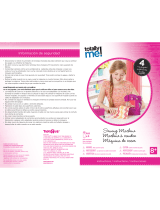
5
INTRODUCTION
Table of Contents
INTRODUCTION ............................................................................................................. 2-5
Welcome ......................................................................................................................................... 2
Important Safety Instructions .......................................................................................................3-4
Table of Contents ............................................................................................................................ 5
ABOUT YOUR MACHINE ............................................................................................... 6-9
Main Parts of the Machine Front ..................................................................................................... 6
Main Parts of the Machine Back ..................................................................................................... 7
Needle and Presser Foot Area ........................................................................................................ 8
Removable Storage Compartment and Accessories ...................................................................... 9
GETTING READY TO SEW ........................................................................................ 10-15
Powering Your Machine ................................................................................................................ 10
Winding the Bobbin ........................................................................................................................11
Inserting the Bobbin ...................................................................................................................... 12
Threading the Upper Thread ......................................................................................................... 13
Automatic Needle Threader .......................................................................................................... 14
Drawing Up the Bobbin Thread ..................................................................................................... 15
START SEWING ......................................................................................................... 16-27
Before You Start Sewing ............................................................................................................... 16
Stitch Formation ............................................................................................................................ 17
LCD Display and Function Buttons ............................................................................................... 18
Stitch Selection ............................................................................................................................. 19
Sewing a Straight Stitch ................................................................................................................ 20
Sewing a Decorative Stitch ........................................................................................................... 21
Sewing a Stretch Stitch ................................................................................................................. 22
Sewing a 1-Step Buttonhole.......................................................................................................... 23
Sewing a Button ............................................................................................................................ 24
Inserting and Changing Needles ................................................................................................... 25
Changing the Presser Foot ........................................................................................................... 26
Sew Easy Foot .............................................................................................................................. 26
Zipper Foot .................................................................................................................................... 27
Helpful LCD Display Messages..................................................................................................... 27
TROUBLESHOOTING AND MAINTENANCE ............................................................ 28-33
Troubleshooting .......................................................................................................................28-32
Maintenance.................................................................................................................................. 33
APPENDIX - GLOSSARY ................................................................................................ 34
Glossary of Key Sewing Terms ..................................................................................................... 34
Explanation key to notations in this manual:
✓
= Helpful information
⚠= Could cause harm
→
= Impacts sewing results
To ensure that you are always provided with the most modern sewing capabilities, the manufacturer reserves the right to change
appearance, design or accessories of this sewing machine when considered necessary.
SINGER
®
& Singer is Sewing Made Easy is a registered trademark of The SINGER
®
Company Limited S.à.r.l. or its afliates.
© 2016 The SINGER
®
Company Limited S.à.r.l. or its afliates. All rights reserved.




















